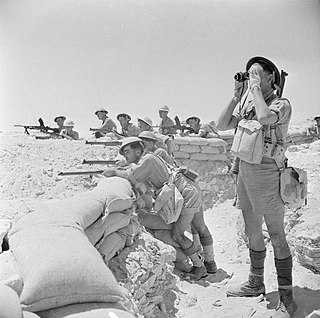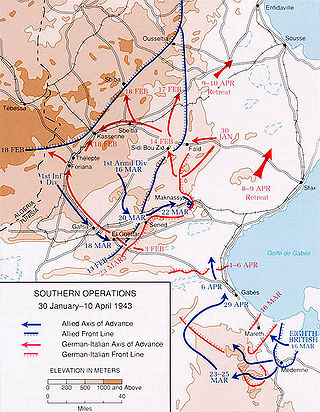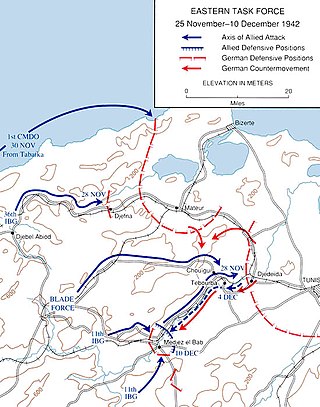
The German Africa Corps, commonly known as Afrika Korps, was the German expeditionary force in Africa during the North African campaign of World War II. First sent as a holding force to shore up the Italian defense of its African colonies, the formation fought on in Africa, under various appellations, from March 1941 until its surrender in May 1943. The unit's best known commander was Field Marshal Erwin Rommel.

The Battle of Kasserine Pass took place from 18-24 February 1943 at Kasserine Pass, a 2-mile-wide (3.2 km) gap in the Grand Dorsal chain of the Atlas Mountains in west central Tunisia. It was a part of the Tunisian campaign of World War II.

The North African campaign of World War II took place in North Africa from 10 June 1940 to 13 May 1943, fought between the Allies and the Axis Powers. It included campaigns in the Libyan and Egyptian deserts, in Morocco and Algeria, and in Tunisia. The Allied war effort was dominated by the British Commonwealth and exiles from German-occupied Europe. The United States officially entered the war in December 1941 and began direct military assistance in North Africa on 11 May 1942.

The Tunisian campaign was a series of battles that took place in Tunisia during the North African campaign of the Second World War, between Axis and Allied forces from 17 November 1942 to 13 May 1943. The Allies consisted of British Imperial Forces, including a Greek contingent, with American and French corps. The campaign opened with initial success by the German and Italian forces but the massive supply interdiction efforts led to the decisive defeat of the Axis. Over 260,000 German and Italian troops were taken as prisoners of war, including most of the Afrika Korps.

The Battle of El Guettar took place during the Tunisia Campaign of World War II, fought between elements of the Army Group Africa under General Hans-Jürgen von Arnim, along with Italian First Army under General Giovanni Messe, and U.S. II Corps under Lieutenant General George Patton in south-central Tunisia. It was the first battle in which U.S. forces were able to defeat the experienced German tank units, but the followup to the battle was inconclusive.

The Battle of Gazala, also the Gazala Offensive was fought near the village of Gazala during the Western Desert Campaign of the Second World War, west of the port of Tobruk in Libya, from 26 May to 21 June 1942. Axis troops of the Panzerarmee Afrika consisting of German and Italian units fought the British Eighth Army composed mainly of British Commonwealth, Indian and Free French troops.

Fritz Hermann Michael Bayerlein was a "quarter-Jewish" German general in the Wehrmacht, during World War II. He initially served as a staff officer, including with Erwin Rommel in the Afrika Korps. He then commanded the 3rd Panzer Division, the Panzer Lehr Division and LIII Army Corps (Wehrmacht) in the European theatre. Bayerlein was a recipient of the Knight's Cross of the Iron Cross with Oak Leaves and Swords. Prior to the second world war, Bayerlein served in the 9th Bavarian Reserve Division in 1917.

The 10th Panzer Division was an armoured division in the German Army, the Heer, during World War II, established in March 1939.
The 21st Panzer Division was a German armoured division best known for its role in the battles of the North African Campaign from 1941 to 1943 during World War II when it was one of the two armoured divisions making up the Deutsches Afrikakorps (DAK). It was first formed as the 5th Light Division in early 1941.
This is a timeline of the North African campaign of World War II.
The Panzerarmee Afrika or referred to as Gruppo Corazzato Africa in Italy was a combined German-Italian field army that fought in the North African campaign during World War II. It consists of one German corps and three Italian corps in the unit. As of 1943. The newly command structure, Army Group Africa were consisted of the German 5th Army and the Italian 1st Army. The unit was under the command of the Italian chain of command in North Africa.

5th Panzer Army was the name of two different German armoured formations during World War II. The first of these was formed in 1942, during the North African campaign and surrendered to the Allies at Tunis in 1943. The army was re-formed in France in 1944, fought in Western Europe and surrendered in the Ruhr pocket in 1945.

Giovanni Messe was an Italian field marshal and politician. In the Second World War, he was captured in Tunisia but made chief of staff of the Italian Co-belligerent Army after the armistice of September 1943. Later, he was an elected representative in the Italian Senate. He is considered by many to have been the best Italian general of the war.

The Battle of the Mareth Line or the Battle of Mareth was an attack in the Second World War by the British Eighth Army in Tunisia, against the Mareth Line held by the Italo-German 1st Army. It was the first big operation by the Eighth Army since the Second Battle of El Alamein 4+1⁄2 months previously. On 19 March 1943, Operation Pugilist, the first British attack, established a bridgehead but a break-out attempt was defeated by Axis counter-attacks. Pugilist established an alternative route of attack and Operation Supercharge II, an outflanking manoeuvre via the Tebaga Gap was planned. Montgomery reinforced the flanking attack, which from 26 to 31 March, forced the 1st Army to retreat to Wadi Akarit, another 40 mi (64 km) back in Tunisia.

General Sir Kenneth Arthur Noel Anderson, was a senior British Army officer who saw service in both world wars. He is mainly remembered as the commander of the British First Army during Operation Torch, the Allied invasion of North Africa and the subsequent Tunisian campaign which ended with the capture of almost 250,000 Axis soldiers. An outwardly reserved character, he did not court popularity either with his superiors or with the public.

The Battle of Medenine was an Axis spoiling attack at Medenine in Tunisia on 6 March 1943. The operation was intended to delay an attack by the British Eighth Army on the Mareth Line. The British had been forewarned by Ultra decrypts of German wireless communications and rushed reinforcements from Tripoli and Benghazi before the Axis attack, which was a costly failure. General Erwin Rommel, the commander of Army Group Africa (Heeresgruppe Afrika), could not afford to lose forces needed for the defence of the Mareth Line and the effort was abandoned at dusk that day.

The 6th Armoured Division was an armoured division of the British Army, created in September 1940 during the Second World War and re-formed in May 1951 in the UK.

Operation Vulcan and Operation Strike were the final ground attacks by the Allied forces against the Italian and German forces in Tunis, Cape Bon, and Bizerte, the last Axis toeholds in North Africa, during the Tunisian campaign of the Second World War.

The Battle of Sidi Bou Zid(Unternehmen Frühlingswind/Operation Spring Breeze) took place during the Tunisia Campaign from 14–17 February 1943, in World War II. The battle was fought around Sidi Bou Zid, where a large number of US Army units were mauled by German and Italian forces. It resulted in the Axis forces recapturing the strategically important town of Sbeitla in central Tunisia.

The Run for Tunis was part of the Tunisia Campaign which took place during November and December 1942 during the Second World War. Once French opposition to the Allied Operation Torch landings had ceased in mid-November, the Allies made a rapid advance by a division-sized force east from Algeria, to capture Tunis and forestall an Axis build up in Tunisia and narrowly failed. Some Allied troops were fewer than 20 miles (32 km) short of Tunis by late November but the defenders counter-attacked and pushed them back nearly 20 miles (32 km), to positions which had stabilised by the end of the year.

















